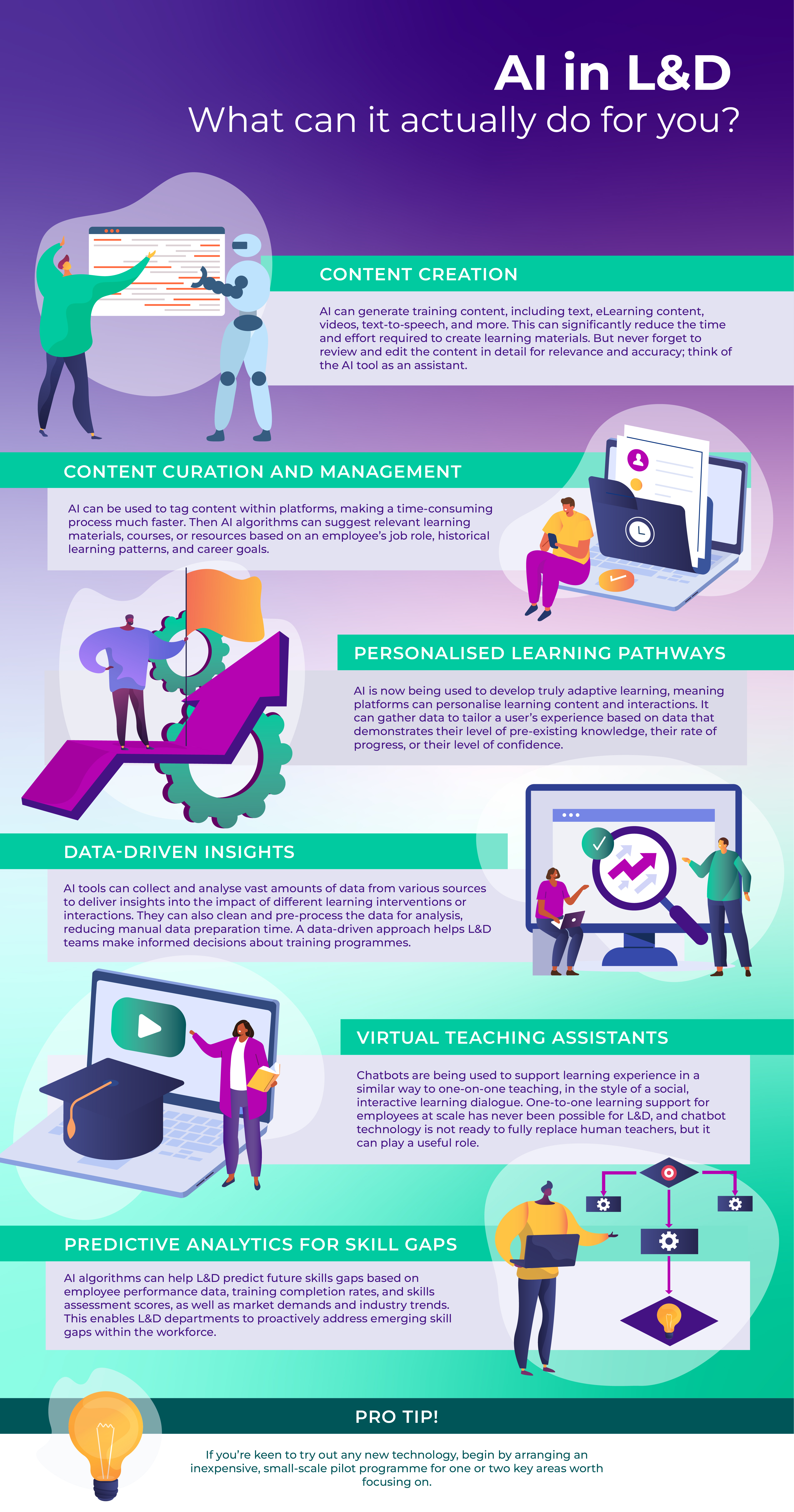At the last Learning Live event in London, the reported No. 1 priority for senior L&D and HR managers was ‘Creating a learning culture’. Yet, this terminology seems odd, surely that's a bit like wanting to create a reading culture in a book club?
What does ‘Create a learning culture’ really mean?
Learning is a naturally occurring, inherent human behaviour. Employee learning happens every day because employees are people, and people naturally seek out ways to be better at their job, feel better about themselves in their job, or at least make things easier for themselves in their work. People learn from experience, from mistakes, and in the case of social learning, from their peers. They remember the pieces of information that are relevant to them and that resonate with their beliefs and feelings.
“If you employ humans, learning happens in your workplace every day”
- B Andreatta, 6 Steps
Why was it that of all the challenges faced by departments today, L&D at Learning Live felt that their top priority was to ‘create’ a culture that already exists? Surely this was a case of a poorly articulated tick box option.
Assuming that the respondents to the survey were answering honestly and thoughtfully, what does ‘Create a learning culture’ really mean, and why is it such a challenge?

What’s wrong with your learning culture?
If business goals are not being met quickly enough, or a leadership team is struggling to execute its business strategy, sometimes it can be easy to blame ‘the learning culture’. It’s easier than blaming the culture of leadership.
On the other hand, many L&D departments find it hard to articulate their vision. This leaves them open to blame for a broken culture at work.
Perhaps a particular form of learning hasn’t been embraced by employees (as can happen, for example, in a company trying to establish an elearning culture). Learning may be happening informally, but not openly and effectively enough for an adaptable workforce, capable of changing with the times.
Consider though that the problem might be more about how the value of learning is perceived among the workforce.
Once an organisation’s leaders examine honestly the perceptions around the value put on it, the question becomes not about creating the culture, but about building a culture that positively impacts business performance.
"High performing organisations are 3x more likely to have a strong learning culture"- Bersin report
Lead the culture change
For an L&D or leadership team to change what ‘learning’ means to an organisation, it may need to change how it sees itself. A challenge for L&D has been the demise into the role of an order-taker – a function that reacts to requests from a C-suite or from employees. A department that goes cap-in-hand asking for a budget to deliver something that might justify its existence.
Whatever leader or manager role you have within L&D, envision yourself as a facilitator and provider of services that are crucial to your organisation’s ability to build new capabilities. Elevate the “culture of learning” within your organisation to stand shoulder-to-shoulder with the “culture of performance”, the “culture of innovation”, the “culture of leadership”.
By asking, “How can I change the perception of the value of learning within my organisation?” this can help form the processes and practices that shape your culture. Research shows:
“Organisations with a strong learning culture are 92% more likely to develop novel products and processes”
Bersin report: Becoming irresistible: A new model for employee engagement
How to build a positive learning culture
Here are 10 ideas for fostering a positive and strong culture:
1. Align talent development to business objectives
To make strategic decisions about the direction of learning, it’s important to be able to quickly and accurately assess the skills levels that exist. Consider modern Skills Gap Analysis methods to assess existing talent. Armed with this data, devise a strategy that supports business objectives.
2. Change the language
You want to know what employees need. You could send an email “..Let me know if you think you need training before the end of the quarter.” But employees feel they’re costing the company money and time. Think about offering a range of strategic services; ready-made solutions, skills training, large scale company programmes, tactical initiatives, a suite of impactful assets. Use the language of a service provider and market your wares.
3. Provide a framework for learning
Curriculum programmes are highly effective in bringing learners along a well-structured learning journey. However, consider creating a formal learning framework, composed of the skills, competencies and values required for different job functions. Include signposting to resources, assets, links or appropriate courses. Employees can use this as a guide for more self-directed learning.
4. Provide a variety of resources and opportunities
There may be limitations to existing learning management systems (LMS); formal training and development programmes might still exist. However, it’s becoming easier to curate content and create simple resources (PDF checklists, useful links, self-recorded videos, screen capture tools, scenario examples) that will sit on your LMS or as standalone assets.
5. Make learning accessible
Integrate learning into the everyday and actively remove as many physical and technical barriers to learning resources will be a promotion strategy in itself. There are many types of non-traditional learning platforms with which an employee engages readily (social media, messaging services, websites, company intranet) and from which information is easy to re-share. Creating and promoting resources that employees can access on the job will help them become an integral part of their job (read more about learning in the flow of work).
6. Encourage ideas and feedback
Sharing ideas and listening to feedback will keep your finger on the pulse of the organisation in terms of the perceived priority of learning opportunities by your workforce. Inviting input improves employee engagement, and provides you with valuable information to measure effectiveness and to shape strategic decisions. Check out the results of an employee engagement ThinkTank held by our fellow division, Forty1.
7. Recognise the champions
A culture where learning is publicised and rewarded can only strengthen it. Care may be needed so as it’s the growth mindset that’s celebrated, not the competitive ticking of LMS boxes. But a culture that acknowledges and empowers the enthusiasts and early-adopters can go along way to retaining top talent.
8. Start with Onboarding
First impressions last. By focusing on knowledge and development expectations within an induction programme, a new employee will expect a culture in which they will learn and grow. Read more about creating good onboarding experiences.
9. Encourage employees to share knowledge
It’s important not to underestimate the effectiveness of social learning. Facilitating Lunch & Learn sessions, a tweet-a-day, collating learning nuggets, etc. will all help to demonstrate the benefits of a culture in which it’s safe to take some risks in the name of innovation. More formal coaching and mentoring programmes will put an emphasis on the value of continuously learning and promoting knowledge sharing.
10. Market the benefits of your new learning culture
In order to keep everyone on board with your culture transformation, look for opportunities to measure and market its benefits. To your senior stakeholders, demonstrate innovation, efficiencies, cost-savings, productivity, talent development, quality and staff morale. To employees, promote acquiring new skills as positive growth, don’t shame them for not knowing. Employee engagement in a learning culture will help avoid a talent crisis.

Organisations with a Strong Learning Culture significantly Outperform their peers…
- 46% more likely to be first to market (innovation)
- 37% greater employee productivity (productivity)
- 34% better response to customer needs (time to market)
- 26% greater ability to deliver “quality products” (quality)
- 58% more likely to have skills to meet future demand
- 17% more likely to be market share leader (profitability)
- Bersin report: High Impact Learning Culture
It follows that a dynamic learning culture will enable an organisation to adapt to changing needs and direction. It could be the difference between being stuck at flat revenue growth with pressure on skill sets, and being able to re-engineer solutions to increase profit and customers.
Talk to us about ideas and tools that will help you transform your culture into a key strategic initiative for performance, success and growth.











Was this article helpful?